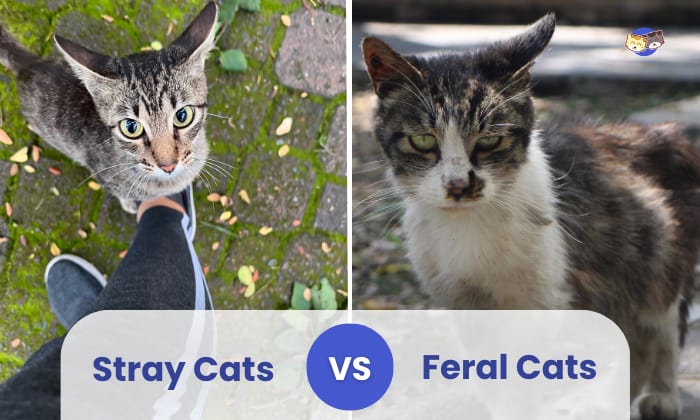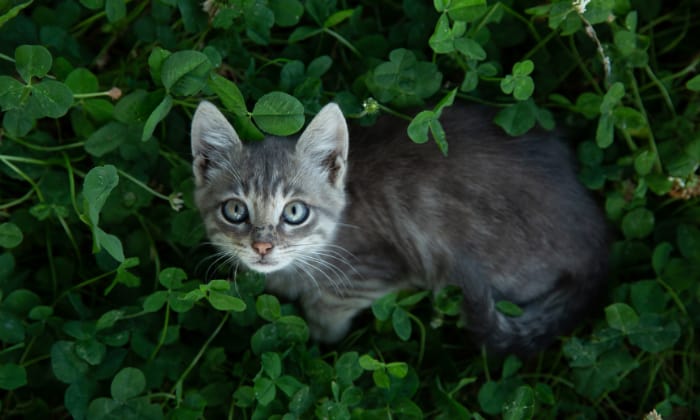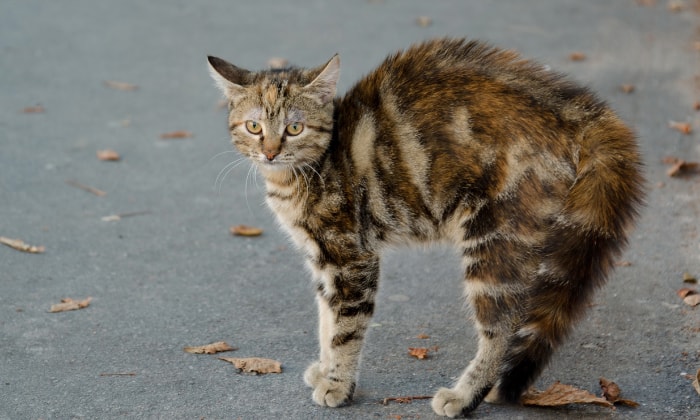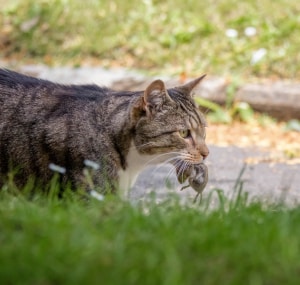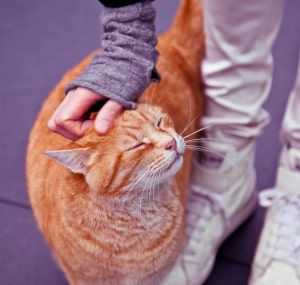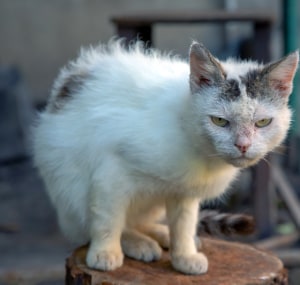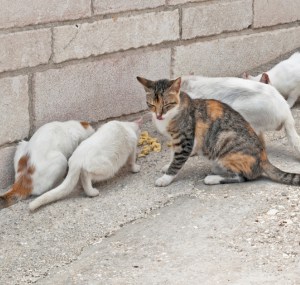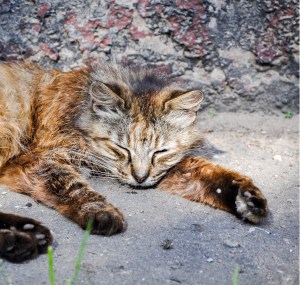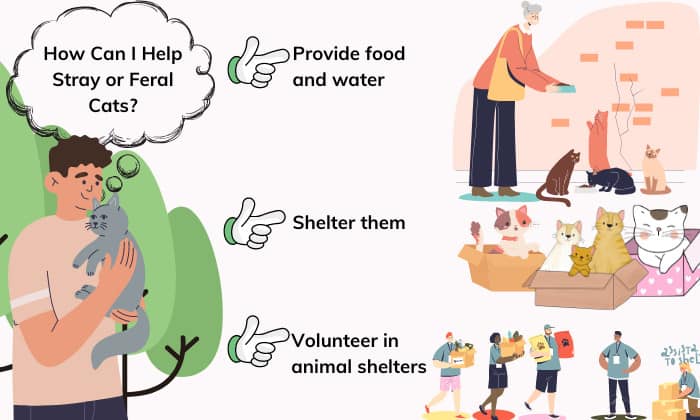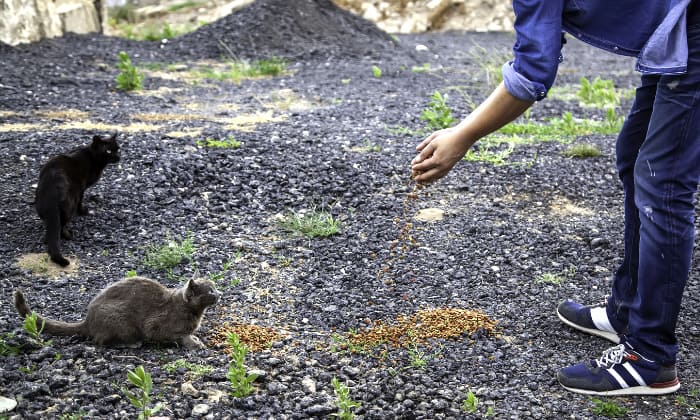If you look outside your home, you will probably see felines with no collars, indicating that they live on the street. The cats you see are either lost, abandoned, or born in the wild.
Two types of cats live outside – stray and feral. These cats share some commonalities, which make them difficult to tell apart.
However, differentiating a stray from a feral cat is vital to know how to interact with them. Read on as this article will discuss everything you need to know about stray vs feral cats.
Table of Contents
Stray Cat Definition
Did you know that a stray cat’s meaning differs from a feral cat’s? You can define stray cats as felines that were once accustomed to socializing with people but were left to fend for themselves.
However, they lost regular human contact at some point due to being lost or abandoned.
Newly-abandoned or lost stray felines may still be socialized, so they will allow people to touch or interact with them. But as they lose regular human contact, they become less socialized and become feral cats.
It is possible to reintroduce stray cats into homes and human care again. However, you need the right approach, as they may feel frightened to interact with people after being used to living outside.
Feral Cat Definition
You might be wondering, “if feral cats are different from stray cats, then what does a feral cat mean?” Feral cats are felines that either never had human interaction or lost human contact long enough to be unaccustomed to their presence. Cats born feral are often afraid of humans, as they have never experienced living with people.
Unlike stray cats, there is a very low chance for feral cats to be tamed. You may try bringing a feral cat into your home, but acclimating it requires much time and attention.
There are also no guaranteed results that a feral cat will become domesticated.
Moreover, understanding feral cat behavior is crucial in knowing how to approach them. The reason is that these cats can carry bacteria and rabies, making them dangerous.
Difference Between Feral and Stray Cats
| Stray Cats | Feral Cats |
| Look skinny and unkempt | Appear healthy and more groomed |
| Familiar with humans, so they may approach and socialize with people | Avoid human interaction at all costs |
| Similar to pet felines | Walk with their tails and bodies crouched low and are vigilant of their surroundings |
| Often live alone, as they are rejected by other cats | Live in colonies |
| Can live for up to four years | Can live for ten years when in a colony |
1. Physical difference
It is common for stray cats to look skinny, although they largely resemble pet felines. They were once used to people taking care of them, so they do not know how to hunt and scavenge for food now that they are in the wild.
On the other hand, feral cats are great hunters, as they have lived in the wild for quite a long time. For this reason, they look as healthy as the pet cats you commonly see.
Some feral cats may also have the pointy part of their ears clipped. Organizations that run a routine trap-neuter-release process clip the ears of the feral cats that they sterilized as a means of identifying them.
2. Behavioral difference
Stray cats are familiar with humans. For this reason, they may approach people and socialize with them.
A stray cat may also rely on humans for food.
Feral cats will never socialize or approach humans at any cost. They live in places where people cannot find them, so even a quick glance at feral felines is rare.
3. Body language
While stray cats can be a little aloof to humans, they have the same body language as pet felines. They have straight backs and upright tails, indicating that they are calm and will not harm those who approach them.
On the other hand, feral cats’ body language indicates that they are keeping their guards up. When walking, feral cats crouch their bodies and tails low, with their eyes continuously scanning their environment.
Unlike stray cats, a feral cat looks like it is always ready to defend itself from people.
4. Social interaction with other felines
Stray felines often live alone. As they did not grow up in the wild, other cats tend to reject them.
However, stray female cats may form small colonies when they get pregnant and give birth to stray kittens.
Feral cats live in colonies. They often roam around suburban, urban, and rural areas where they can find a consistent source of food and shelter.
The colonies of feral cats can range from a few felines to dozens. They also have a hierarchy, with dominant felines acting as the leader.
5. Lifespan
The lifespan of stray cats ranges from 4 to 8 years. Since they are not used to fending for themselves, they are at risk of accidents, death, and malnutrition.
Stray cats can also get infected with diseases, which can cause them death without medical attention.
Meanwhile, the lifespan of a feral cat that is living singly can only range from one to two years. But if they live in a colony, they may live for up to a decade.
How Can I Help Stray or Feral Cats?
Stray and feral cats often need help, as they may be sick, malnourished, or injured. Here are some steps you can take if you want to help stray and feral cats.
1. Provide food and water.
The easiest way to help stray and feral cats are to leave dry food or water outside. Make sure that you leave the food and water at a secure location that felines can quickly access.
2. Shelter them
Stray and feral cats need shelter. This shelter can be as simple as a cardboard box lined with straw or blankets to keep felines warm.
3. Volunteer in animal shelters
It is not recommended to touch stray and feral cats yourself. Community cats, particularly feral cats, are dangerous as they may carry infectious diseases.
So, the best thing to do is to volunteer in shelters or organizations that help stray and feral cats.
What is Socialization and Why Does It Matter in Cats?
Socialization is the process of exposing cats to people, experiences, and other animals in a controlled and positive way while they are still two to seven weeks old. This process helps them adjust to their environment and improve their behavior and quality of life.
It is important for felines to undergo socialization to help them develop the necessary social skills. It also makes them confident to interact with humans and other animals.
Socialization prevents cats from feeling fear and aggression toward humans. Felines that have undergone socialization are more comfortable around people, making them easy to adopt and care for.
Frequently Asked Questions
What makes a cat feral?
Felines are considered feral when they never experienced human contact. As mentioned, some feral cats were once pet felines, but they have lost human contact long enough to be no longer accustomed to it.
Signs a stray cat likes you
The primary sign that a stray cat likes you is when it allows you to approach it. It may even approach you on its own by rubbing its body against your legs.
Signs of a semi-feral cat
Like stray cats, semi-feral felines may socialize with humans by making eye contact or vocalizing in front of you. But like feral cats, they avoid physical contact and may run away if you get too close.
How to tell if a cat is feral
You can tell that a feline is feral by looking at its body language. As mentioned, a feral cat usually walks with its tail lowered down while observing its surroundings.
Conclusion
Helping stray and feral cats is crucial, as their population is continuously increasing. If you want to help community cats, you can support and donate to organizations that run a catch-neuter-release program.
This way, you can help lower the population of felines that live without human caretakers. You may also contact rescue organizations if you see a community cat that needs help.
Furthermore, we hope that this post helped you differentiate between stray vs feral cats.
Read more: Bengal cat vs domestic cat: Difference?

I am Amy Sawy, a Doctor of Veterinary Medicine (DVM) graduate from the University of Kansas. y husband, Dr. Plummer, and I own a veterinary clinic in Phillipsburg, Kansas. In addition to my professional background, I am a devoted pet owner myself, with a household that includes dogs, rodents, and most notably, cats – a total of five felines in my home.
In 2020, I joined an organization as a professional writer, leveraging my experience and collaborating with my team to deliver the most valuable information for your cat’s care.


